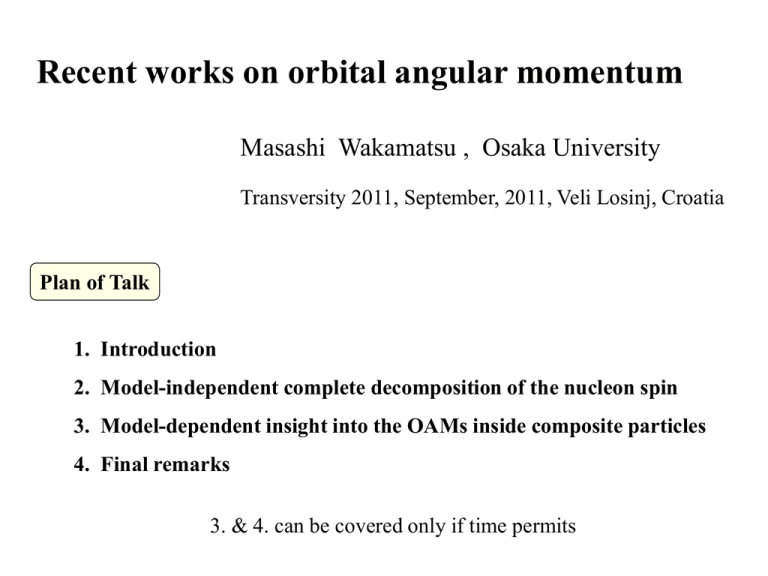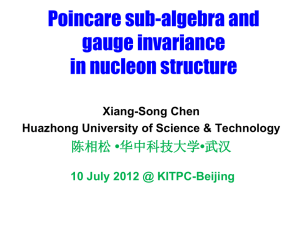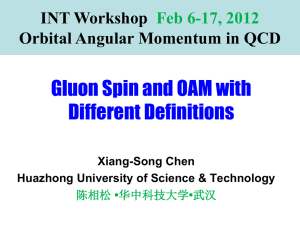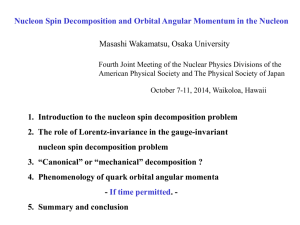transversity2011_Wakamatsu
advertisement

Recent works on orbital angular momentum Masashi Wakamatsu , Osaka University Transversity 2011, September, 2011, Veli Losinj, Croatia Plan of Talk 1. Introduction 2. Model-independent complete decomposition of the nucleon spin 3. Model-dependent insight into the OAMs inside composite particles 4. Final remarks 3. & 4. can be covered only if time permits 1. Introduction current status and homework of nucleon spin problem What carries the remaining 2 / 3 of nucleon spin ? quark OAM ? gluon spin ? gluon OAM ? To answer this question unambiguously, we cannot avoid to clarify • What is a precise definition of each term of the decomposition ? • How can we extract individual term by means of direct measurements ? especially controversy are orbital angular momenta ! 2. Model-independent complete decomposition of the nucleon spin Two popular decompositions of the nucleon spin common Each term is not separately gauge-invariant ! No further decomposition of ! - continued - common different An especially important observation is that, since one must conclude that New gauge-invariant decomposition by Chen et al. X.-S. Chen et al., Phys. Rev. Lett. 103, 062001 (2009) ; 100, 232002 (2008). The basic idea with and Chen et al.’s decomposition • Each term is separately gauge-invariant ! • It reduces to gauge-variant Jaffe-Manohar decomposition in a particular gauge ! Chen et al.’s papers arose quite a controversy on the feasibility of complete decomposition of nucleon spin. • • • • • • • X. Ji, Phys. Rev. Lett. 104 (2010) 039101 : 106 (2011) 259101. S.C. Tiwari, arXiv:0807.0699. X.S. Chen et al., arXiv:0807.3083 ; arXiv:0812.4336 ; arXiv:0911.0248. Y.M. Cho et al., arXiv:1010.4336 ; arXiv:1102.1130. X.S. Chen et al., Phys.Rev. D83 (2011) 071901. E. Leader, Phys. Rev. D83 (2011) 096012. Y. Hatta, arXiv:1101.5989. …………………………. We believe that we have arrived at one satisfactory solution to the problem, step by step, through the following three papers : (i) M. W., Phys. Rev. D81 (2010) 114010. (ii) M. W., Phys. Rev. D83 (2011) 014012. (iii) M. W., Phys. Rev. D84 (2011) 037501. In the paper (i), we have shown that the way of gauge-invariant decomposition of nucleon spin is not necessarily unique, and proposed another G.I. decomposition : where “potential angular momentum” • The quark part of our decomposition is common with the Ji decomposition. • The quark and gluon intrinsic spin parts are common with the Chen decomp. • A crucial difference with the Chen decomp. appears in the orbital parts The QED correspondent of this term is the orbital angular momentum carried by electromagnetic field, appearing in the famous Feynman paradox in his textbook. An arbitrariness of the spin decomposition arises, since this potential angular momentum term is solely gauge-invariant ! since This means that one has a freedom to shift this potential OAM term to the quark OAM part in our decomposition, which leads to the Chen decomposition. In the paper (ii), we found that we can make a covariant extension of the gauge-invariant decomposition of nucleon spin. covariant generalization of the decomposition has twofold advantages. (1) It is essential to prove Lorentz frame-independence of the decomposition. (2) It generalizes and unifies the nucleon spin decompositions in the market. Basically, we find two physically different decompositions (I) and (II) . The starting point is again the decomposition of gluon field, similar to Chen et al. Different from their treatment, we impose the following general conditions alone : and • As already mentioned, these conditions are not enough to fix gauge uniquely ! • However, the point of our analysis is that we can postpone a concrete gauge-fixing until later stage, while accomplishing a gauge-invariant decomposition of based on the above general conditions alone. Again, we find the way of gauge-invariant decomposition is not unique. decomposition (I) & decomposition (II) Gauge-invariant decomposition (II) : covariant generalization of Chen et al’s with This decomposition reduces to any ones of Bashinsky-Jaffe, of Chen et al., and of Jaffe-Manohar, after an appropriate gauge-fixing in a suitable Lorentz frame, which means that these 3 decompositions are all gauge-equivalent ! They are not recommendable decompositions, however, because the quark and gluon OAMs in those do not correspond to known experimental observables ! Gauge-invariant decomposition (I) : our recommendable decomposition with full covariant derivative covariant generalization of potential OAM ! The superiority of this decomposition is that the quark and gluon OAMs in this decomposition can be related to experimental observables ! The physical nonequivalence of the 2 decompositions is also clear from a “toy model” analysis of Burkardt and BC (Phys. Rev. D79 (2009) 071501). Using scalar diquark model & QED and QCD to order a, they compared the fermion OAMs obtained from the Jaffe-Manohar and Ji decompositions. In our terminology, these two fermion OAMs are nothing but canonical OAM & dynamical OAM [Their findings] • 2 decompositions give the same fermion OAMs in scalar diquark model, but they do not in QED and QCD (gauge theories). • x- distribution of fermion OAMs are different even in scalar diquark model. • in QED and QCD at order a Unfortunately, the details are heavily model-dependent ! An important lesson is that one should clearly distinguish two kinds of OAMs : canonical OAM (or its nontrivial gauge-invariant extension) & dynamical OAM the difference of which is nothing spurious, i.e., physical ! The following shows a power balance of supporters of two kinds of OAMs : canonical OAM party dynamical OAM party • Jaffe-Manohar • Bashinsky-Jaffe • Chen et al. • Cho et al. • Leader • Ji • Wakamatsu Neutral party • Burkardt-BC • Superiority of the decomposition (I) The keys are the following identities, which hold in our decomposition (I) : quark : and gluon : with Evaluating the nucleon forward M.E. of the component (in rest frame) or component (in IMF) of the above equalities, we can prove the following crucial relations : For the quark part with In other words the quark OAM extracted from the combined analysis of GPD and polarized PDF is “dynamical OAM” (or “mechanical OAM”) not “canonical OAM” ! This conclusion is nothing different from Ji’s claim ! For the gluon part (this is totally new) with The gluon OAM extracted from the combined analysis of GPD and polarized PDF contains “potential OAM” term, in addition to “canonical OAM” ! It is natural to call the whole part the gluon “dynamical OAM” . Finally, in the paper (iii), we investigated the role of quantum-loop effects. general reasoning deduced from the widely-accepted decomposition : both gauge-invariant and measurable ! quark part (transparent) gauge-invariant and measurable ! gauge-invariant and measurable ! gluon part (delicate) If logical conclusion is really gauge-invariant and measurable ! gauge-invariant and measurable ! [key question] Is really gauge-invariant ? delicate question In fact, it was often claimed that has its meaning only in the LC gauge and in the infinite-momentum frame (for instance, by X. Ji and P. Hoodbhoy). More specifically, in • P. Hoodbhoy, X. Ji, and W. Lu, Phys. Rev. D59 (1999) 074010. they claim that evolves differently in the LC gauge and the Feynman gauge. However, the gluon spin operator used in their Feynman gauge calculation is which is delicately different from our gauge-invariant gluon spin operator The problem is how to introduce this difference in the Feynman rule of evaluating 1-loop anomalous dimension of the quark and gluon spin operator. This problem was attacked and solved in our 3rd paper (iii) M. W., Phys. Rev. D84 (2011) 037501. We find that the calculation in the Feynman gauge (as well as in any covariant gauge including the Landau gauge) reproduces the answer obtained in the LC gauge, which is also the answer obtained by the Altarelli-Parisi method. Our finding is important also from another context. So far, a direct check of the answer of Altarelli-Pasiri method for the evolution equation of within the operator-product-expansion (OPE) framework was limited to the LC gauge calculation, because it was believed that there is no gauge-invariant definition of gluon spin in the OPE framework. This is the reason why the question of gauge-invariance of in unclear status for a long time ! has been left Now we can definitely say that the gauge-invariant gluon spin operator appearing in our nucleon spin decomposition (although nonlocal) certainly provides us with a satisfactory operator definition of gluon spin operator (with gauge-invariance), which has been searched for nearly 40 years. Summary at this point We emphasized the existence of 2 kinds of OAMs in the nucleon. It was shown that at least the dynamical OAMs of quarks and gluons in the nucleon can be extracted model-independently from the combined analysis of GPD measurements and polarized DIS measurements. This means that we now have a satisfactory theoretical basis toward a complete decomposition of the nucleon spin, which is a strongly-coupled relativistic bound state of quarks and gluons. 3. Model-dependent insight into the OAMs inside composite particles We have shown that the dynamical OAMs of quarks and gluons in the nucleon can be related to direct observables ! An immediate question is the observability of the canonical OAMs ? If they are also observables, it means that we can isolate the correspondent of the potential angular momentum term appearing in Feynman’s paradox ! Unfortunately, we conjecture that we can access the canonical OAMs inside composite particles only model-dependently, i.e. within the framework of a specific theoretical model. See the discussion below. A model-dependent sum rule for the quark OAM in the nucleon • H. Avakian et al., Phys. Rev. D78 (2008) 114024 ; D81 (2010) 074035. In MIT bag model (later, also in scalar diquark model), they derived the sum rule pretzolocity Here, with , we have Here This is the quantity appearing in the nucleon spin sum rule in the MIT bag model. However, one must recognize the fact that the probability , which gives a measure of the quark OAM, has its meaning only within a particular model ! To deepen this statement, let us consider far simpler composite system, i.e. deuteron ; a bound state of p & n magnetic moment of deuteron (in the simplest approximation) deuteron w.f. and S- and D-state probabilities angular momentum decomposition of deuteron spin Several obstacles to this simple thought are relativistic corrections, meson exchange currents, ..... Most serious is the fact that the D-state probability is not a direct observable ! • R.D. Amado, Phys. Rev. C20 (1979) 1473. • J.L. Friar, Phys. Rev. C20 (1979) 325. The “interior” of a bound state w.f. cannot be determined empirically. 2-body unitary transformation arising in the theory of meson-exchange currents can change the D-state probability, while keeping the deuteron observables intact. The D-state probability, for instance, depends on the cutoff of short range physics in an effective theory of 2-nucleon system. • S.K. Bogner et al., Nucl. Phys. A784 (2007) 79. See the figure in the next page ! Deuteron D-state probability in an effective theory Bogner et al, 2007 4. Final remarks At any rate, one must clearly recognize the fact that, even for an extremely simple bound system like the deuteron, the D-state probability or the OAM content is not a direct observable ! I point out that the OAMs appearing in these model-dependent consideration, are expectation values of “canonical OAM operator” between some Fock-state eigenvectors ! The canonical momentum as well as the canonical OAM are fundamental ingredients of quantum mechanics and/or quantum field theory. However, whether they correspond to direct observables is a totally different thing ! Of course, I never deny the importance of theoretical models in studying the nucleon spin contents. However, when you want to discuss the quark and gluon OAMs in the nucleon, you must be very clearly conscious of which OAMs you are discussing ! canonical OAM or dynamical OAM ? [Backup Slides] [Short summaries of the findings of our 3 papers] paper (i) : proposal of another gauge-invariant decomposition of nucleon spin • There exist 2 different gauge-invariant decompositions of nucleon spin. paper (ii) : covariant extension of the GI decomposition of nucleon spin. • The decompositions of Chen et al, of Bashinsky-Jaffe, and of Jaffe-Manohar are all gauge equivalent, i.e. they are physically the same decomposition ! • A superiority of our decomposition, which is different from the above, is that each term of the decomposition can be related to concrete DIS observables ! paper (iii) : gauge-independence of gluon spin and its evolution • We have carried out explicit one loop calculation of the anomalous dimensions in arbitrary covariant gauges to find that the evolution of is independent of the choice of gauge ! [Backup Slide 1] gauge-invariance of the evolution of gluon spin quark and gluon spin operator in our GI decomposition a little more explicit form with In the LC gauge , only the term survives ! The question is how to introduce this unique feature of our gluon spin operator into Feynman rules for evaluating relevant anomalous dimensions ! The gluon propagator in general covariant gauge arbitrary gauge parameter Since one of the gluon field appearing in our gluon spin operator is its physical part, we must replace the gluon propagator by when one of the endpoint of gluon propagator is obtained by the contraction with the physical part of gluon in our gluon spin operator. Here, we need a sum of the product of gluon polarization vectors over two physical polarization states (not including the scalar and longitudinal polarization states). The answer is given in the textbook by Bjorken and Drell : where being an arbitrary 4-vector subject to the conditions : For practical calculation, it is convenient to take satisfying . to be a light-like 4-vector In this case, the modified gluon propagator reduces to which precisely coincides with the gluon propagator in the LC gauge. This does not mean we are working in the LC gauge from the very beginning. In fact, if we did so, there would be no contributions to anomalous dimensions from the operators and . It is crucial to use the above modified propagator only when one of the endpoint of the gluon propagator is obtained by the contraction with the physical part of in our gluon spin operator. In other places, one should use the standard gluon propagator, which, for instance in the Feynman gauge, is given by The momentum space vertex operators for the gluon spin Here, is a sort of projection operator, which reminds us of the fact that we must use the modified gluon propagator , whenever it contains the Lorentz index . The Feynman diagrams contributing to relevant anomalous dimensions + field strength (FS) renormalization graphs [Backup Slide 2] Chen et al.’s decomposition of linear momentum where This decomposition is different from the standardly-accepted decomposition and they claim that it leads to the following nonstandard prediction for the asymptotic values of quark and gluon momentum fractions : However, this claim is probably wrong, as we shall discuss below ! existing decomposition of OCD energy momentum tensor generalized potential momentum term ! What do these decompositions mean for the momentum sum rule of QCD ? Take light-cone (LC) gauge component in any of the 4 decompositions then reduce to Interaction-dependent part drops in the LC gauge and infinite-momentum frame ! Thus, from - Jaffe - we obtain the standard momentum sum rule of QCD : Even Chen decomposition gives the standard sum rule, contrary to their claim ! The point is that the difference between does not appear in the longitudinal momentum sum rule, since ! However, this is not the case for the angular momentum sum rule. In fact, the difference between does not vanish even in LC gauge and IMF, since physical components, which cannot be transformed away by any gauge transformation ! [Backup Slides 3] Why can we observe “dynamical OAM” ? • motion of a charged particle in static electric and magnetic fields (See the textbook of J.J. Sakurai, for instance.) Hamiltonian Heisenberg equation One finds Equation of motion What appears in Newton’s equation of motion is dynamical momentum not canonical one. “Equivalence principle” of Einstein dictates that the “flow of mass” can in principle be detected by using gravitational force as a probe. As a matter of course, the gravitational force is too weak to be used as a probe of mass flow in microscopic system. However, remember the fact that the 2nd moments of unpolarized GPDs are also called the gravito-electric and gravito-magnetic form factors. The fact that the dynamical OAM as well as dynamical linear momentum can be extracted from GPD analysis is therefore not a mere accident ! [Backup slide 4A] A short review of the Feynman paradox 1. Initially, the disk is at rest. coil of wire battery 2. Shut off the electric current at some moment. Question Does the disk begin to rotate, or does it continue to be at rest ? plastic disk charged metal balls Answer (A) Since an electric current is flowing through the coil, there is a magnetic flux along the axis. When the current is stopped, due to the electromagnetic induction, an electric field along the circumference of a circle is induced. Since the charged metal ball receives forces by this electric field, the disk begins to rotate ! Answer (B) Since the disk is initially at rest, its angular momentum is zero. Because of the conservation of angular momentum, the disk continue to be at rest ! 2 totally conflicting answers ! Feynman’s paradox The paradox is resolved, if one takes account of the angular momentum carried by the electromagnetic field or potential generated by an electric current ! The answer (A) is correct ! [Backup Slides 4B] A simplified model of the Feynman paradox • J.M. Aguirregabiria and A. Hernandez, Eur. J. Phys. 2 (1981) 168. z A current I is flowing in a small (nearly pointlike) ring so that it has a magnetic moment small ring hole A charge +q is located at This disk is initially at rest. The vector potential at a point by the small ring is +q created a plastic disk x Now, the magnetic moment is slowly decreased. The induced electric fields has a tangential component. Torque y When m becomes 0, the angular momentum of the disk is However, since the angular momentum of the disk is initially zero and if it must be conserved, the disk must be at rest. basically the Feynman paradox We must consider the angular momentum carried by the e.m. field (or potential) Using the identity with we can write as with The 2nd term vanishes, since satisfies Using the Gauss law, the 3rd term also vanishes, since Then, noting that . . , we get That is This exactly coincides with the previously-derived angular momentum of the plastic disk in the final state ! -- OAM carried by e.m. field or potential --







